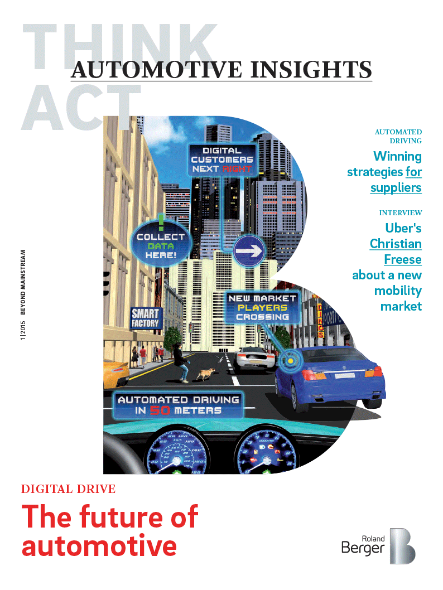Automotive Insights 2015: The future of automotive
![{[downloads[language].preview]}](https://www.rolandberger.com/publications/publication_image/cover_accinsights2015_download_preview.png)
A transition phase, a sea change, a revolution – the recent developments in the automotive industry have been called many things.


All roads in the automotive industry are leading towards digitization. Automotive’s march down the road of digital progress is constantly being met with obstacles, however, from the limitations of technological improvement to the attitude of both customers and businesses. Trust in automated driving has reached a global average of 57%, but spans anything between 28% in Japan and 95% in Brazil. Rolling out digitized products will be a slow process, even after the models are completely market-ready and all legal hurdles have been overcome. When we asked digital pioneer Christian Freese, head of Uber Germany, he forecast that it would be at least five years before automated driving truly hit the streets.
Progress may seem slow, but there’s a race to claim market share of the new business digital trends are generating. We can expect to see more car users as youth and the elderly take advantage of automated driving, and while there will be fewer cars per owner, sales volumes are still expected to increase.
In our study into the future of automotive, we’ve identified three main areas that OEMs should be focusing on to gain a competitive edge in tomorrow’s marketplace: analyzing digitization and its new business opportunities, for example in digital data, automation, multichannel customer interfaces, and connectivity; rethinking mobility and people's changing mobile behavior; and practicing automated driving with flawless navigation, human machine interface (HMI), and vehicle control.

The world's biggest automotive markets don't need to be told twice, however. Chinese companies are already showing healthy competition and innovation in the building an e-sales ecosystem. The rise of mobility-on-demand and capacity efficiency in the U.S. makes it the most likely birthplace for future concepts of vehicle ownership, and although vehicle participation is expected to fall, more able “drivers” of driverless cars will keep up demand for fleets of mobility pods. Meanwhile in the present day, online channels are already professionalizing Brazil's ever growing car market.
The deeper you delve into the story of automotive digitization, the clearer it becomes: this is no ordinary evolution, but the beginning of the automotive chapter of the Digital Revolution.

![{[downloads[language].preview]}](https://www.rolandberger.com/publications/publication_image/cover_accinsights2015_download_preview.png)
A transition phase, a sea change, a revolution – the recent developments in the automotive industry have been called many things.